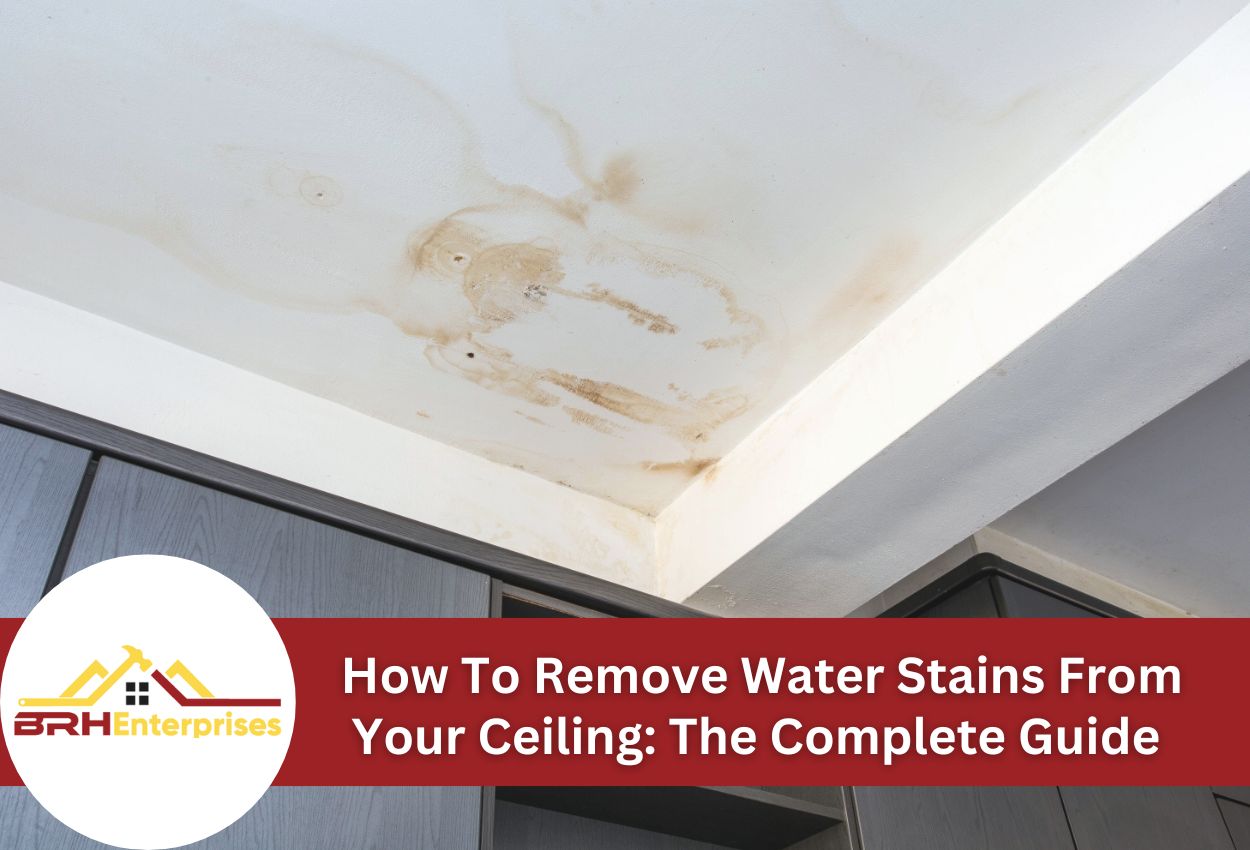How To Remove Water Stains From Your Ceiling: The Complete Guide
Estimated Reading Time : 6 Min.

Water stains on your ceiling aren’t just ugly to look at, they’re warning signs that shouldn’t be ignored. For Wisconsin homeowners, these brown or yellowish areas of discoloration often appear following heavy rainstorms, winter thaws, or plumbing mishaps. This makes ceiling water stain removal a priority for maintaining both your home’s appearance and structural integrity. The high humidity levels during Wisconsin summers can worsen moisture problems, making prompt treatment essential.
Left untreated, what begins as a small spot of discoloration can lead to serious problems, including mold growth, deteriorated insulation, and compromised structural elements. While fixing a water-damaged ceiling is best solved with professional intervention, with the right approach, many homeowners can effectively eliminate these blemishes and restore their ceilings to pristine condition.
Identifying the Source of Your Ceiling Water Stain
Before you can effectively tackle ceiling water stain removal, you need to determine exactly where the water is coming from. Wisconsin homes face unique challenges with seasonal weather extremes that can create multiple potential sources for ceiling leaks. Examining the stain itself provides valuable clues, since roof leaks typically create yellowish-brown stains with irregular edges, while plumbing leaks often produce darker, more concentrated forms of discoloration. Condensation issues usually result in lighter stains with mold or mildew presence.
Location matters significantly in identifying the source as well. Stains near exterior walls might indicate ice dam problems, especially in older Wisconsin homes during the winter. Spots directly beneath bathrooms or kitchens typically point to plumbing issues, while stains in attic-adjacent ceilings often stem from roof penetrations or damaged shingles.
A moisture meter is a valuable tool for tracing the water’s path. These devices detect dampness within walls and ceilings, helping you follow the moisture to its entry point. For suspected roof leaks, inspect your attic during the day when light seeping through the roof deck is visible. Water testing can also be effective, so have someone spray water on the roof in sections while you monitor the ceiling for increased moisture.
Essential Supplies for DIY Ceiling Stain Removal
Tackling ceiling water stains effectively requires having the right tools and materials on hand before you begin. For complete ceiling leak stain repair, gather these essential items:
- A sturdy ladder
- Drop cloths to protect the floor
- Cleaning supplies (bucket, sponges, clean cloths)
- TSP (trisodium phosphate) cleaner or white vinegar solution
- Stain-blocking primer specifically designed for water damage
- Ceiling paint (preferably mold-resistant)
- Application tools, including paintbrushes and rollers with extension poles
- Sandpaper for surface preparation.
Safety should never be overlooked when working overhead. Equip yourself with protective eyewear, a mask or respirator to prevent inhaling dust particles, and rubber gloves to shield skin from cleaning chemicals. Wisconsin homeowners dealing with high ceilings should consider ladder stabilizers for added security during ceiling water spot removal projects.
Budget-conscious DIYers can effectively manage ceiling water stain removal without breaking the bank. Instead of specialized cleaners, a homemade solution of bleach and water (1:3 ratio) works well for most stains. Regular household vinegar can replace commercial cleaners for milder forms of discoloration. While dedicated stain-blocking primers yield the best results, many Wisconsin homeowners find that applying multiple coats of less expensive oil-based primers provides a comparable roof leak ceiling stain treatment.
Step-by-Step Stain Removal Process
Properly removing water stains from your ceiling requires careful preparation and technique to ensure lasting results. Before tackling your ceiling water stain removal project, it’s essential to prepare the affected area thoroughly. Start by moving furniture away from the work zone or covering it with plastic sheeting. Place drop cloths on the floor to protect against drips and spills and ensure the room is well-ventilated by opening windows or using fans, as many cleaning solutions and primers release fumes that shouldn’t be inhaled in concentrated amounts.
For mild surface stains, begin by mixing a solution of one part bleach to three parts water. Using a sponge, gently dab (don’t scrub) the stained area and allow it to dry completely. For stubborn ceiling water spots, a stronger TSP solution may be necessary. Apply with light pressure to avoid damaging the ceiling material. After cleaning, apply a stain-blocking primer specifically formulated for water damage, ensuring complete coverage of the stained area plus several inches beyond its perimeter.
Deep-set water damage will require a different approach. You should start by checking if the ceiling material is still structurally sound. Soft, sagging drywall indicates severe damage and may need replacement in order to effectively fix the stain and the underlying problem.
Applying Stain-Blocking Primers and Paint
The success of your ceiling water stain repair largely depends on using the right primer. For most Wisconsin homes, oil-based stain-blocking primers work best as they create a superior seal against water-soluble tannins that cause discoloration. Water-based shellac primers are excellent alternatives for quicker drying times and less odor. For textured ceilings, spray-on primers provide better coverage in the nooks and crannies where brush application might fall short.
Apply primer with deliberate, even strokes that extend at least two inches beyond the visible stain. This prevents a halo effect, where stained edges might bleed through over time. Allow the primer to dry completely (which typically takes 24 hours in Wisconsin’s varying humidity levels) before assessing whether a second coat is needed. For particularly stubborn stains on plaster ceilings common in older Southern Wisconsin homes, two primer coats are often necessary.
When matching your ceiling paint, take a small sample (about the size of a quarter) from an inconspicuous area to your local hardware store for precise color matching. For textured ceilings, test the new paint on a small section first to ensure it blends seamlessly.
Preventing Future Ceiling Water Stains
After successfully removing unsightly water stains from your ceiling, the last thing you want is to repeat the process. Wisconsin’s weather patterns present special challenges that require proactive maintenance to prevent future ceiling damage. Regular roof inspections — ideally in spring and fall — allow you to find and handle minor problems before they turn into major leaks. Pay particular attention to flashing around chimneys and vents, as these are common entry points for water, especially after severe weather events frequent in Southern Wisconsin.
Ice dams represent one of the most common threats to Wisconsin homes during the winter. These formations occur when heat escaping from your attic melts snow on the roof, which then refreezes at the eaves, creating a barrier that traps water. Proper attic insulation and ventilation are your best defenses against ice dams. If you feel it’s helpful, you could install heat cables along the roof’s edges to maintain clear drainage paths during freeze-thaw cycles.
Inside your home, managing humidity levels is essential to prevent condensation-related ceiling stains. Bathroom and kitchen exhaust fans should vent completely outside, not into attic spaces, and be used consistently during high-moisture activities. For plumbing protection, insulate pipes in unheated areas and know the location of your main water shutoff valve for quick response to emergencies. Regular checks of washing machine hoses, water heater connections, and under-sink plumbing can catch minor issues before they create ceiling water damage that requires extensive repairs.
When to Call a Professional Roofing Contractor
While many ceiling water stains can be addressed with DIY methods, certain situations demand professional expertise. If your stain reappears shortly after treatment, continues to grow, or is accompanied by sagging drywall, these are red flags that shouldn’t be ignored. Multiple stains appearing in a pattern may indicate systematic roof failure rather than an isolated leak. Wisconsin homeowners should be particularly cautious of stains that develop black mold, as humidity can accelerate harmful growth that poses health risks.
Structural concerns that warrant immediate professional attention include ceiling materials that feel soft to the touch, visible warping or buckling of ceiling panels, or water stains that appear after heavy snow melt, suggesting potential issues with the roof being able to handle weight. Electrical fixtures surrounded by water stains present serious safety hazards requiring licensed contractors. Keep in mind that if your home is over 20 years old with the original roof, what seems like a simple stain might actually signal the need for a roof replacement.
When interviewing potential contractors, ask about their licensing, insurance coverage, and experience with your specific type of ceiling and roofing materials. Request references from similar projects and verify their warranty terms, as reputable Wisconsin contractors typically offer 1 to 2 year workmanship warranties on ceiling water damage repairs. Discuss their diagnostic approach with them, as qualified professionals should thoroughly inspect both your ceiling and roofing system rather than offering quick-fix solutions. They should also offer a detailed written estimate with a realistic timeline that demonstrates professionalism and helps ensure your ceiling stain problems are resolved properly the first time.
Expert Ceiling Water Stain Solutions at BRH Enterprises LLC
If you’ve discovered a water stain on your ceiling and are unsure about the best way to address it, consider calling the professionals. At BRH Enterprises LLC, we specialize in identifying the source of ceiling water stains and providing effective, long-lasting solutions. Water stains can be more than just unsightly, they could indicate deeper structural issues or lead to mold growth and health concerns if they’re not addressed promptly.
Don’t let a small stain turn into a big problem. Our team has the expertise to not only remove the stains but also prevent future issues. For expert ceiling leak stain repair in Wisconsin, call BRH Enterprises LLC at (920) 249-4228, and ensure your home remains beautiful and structurally sound.


